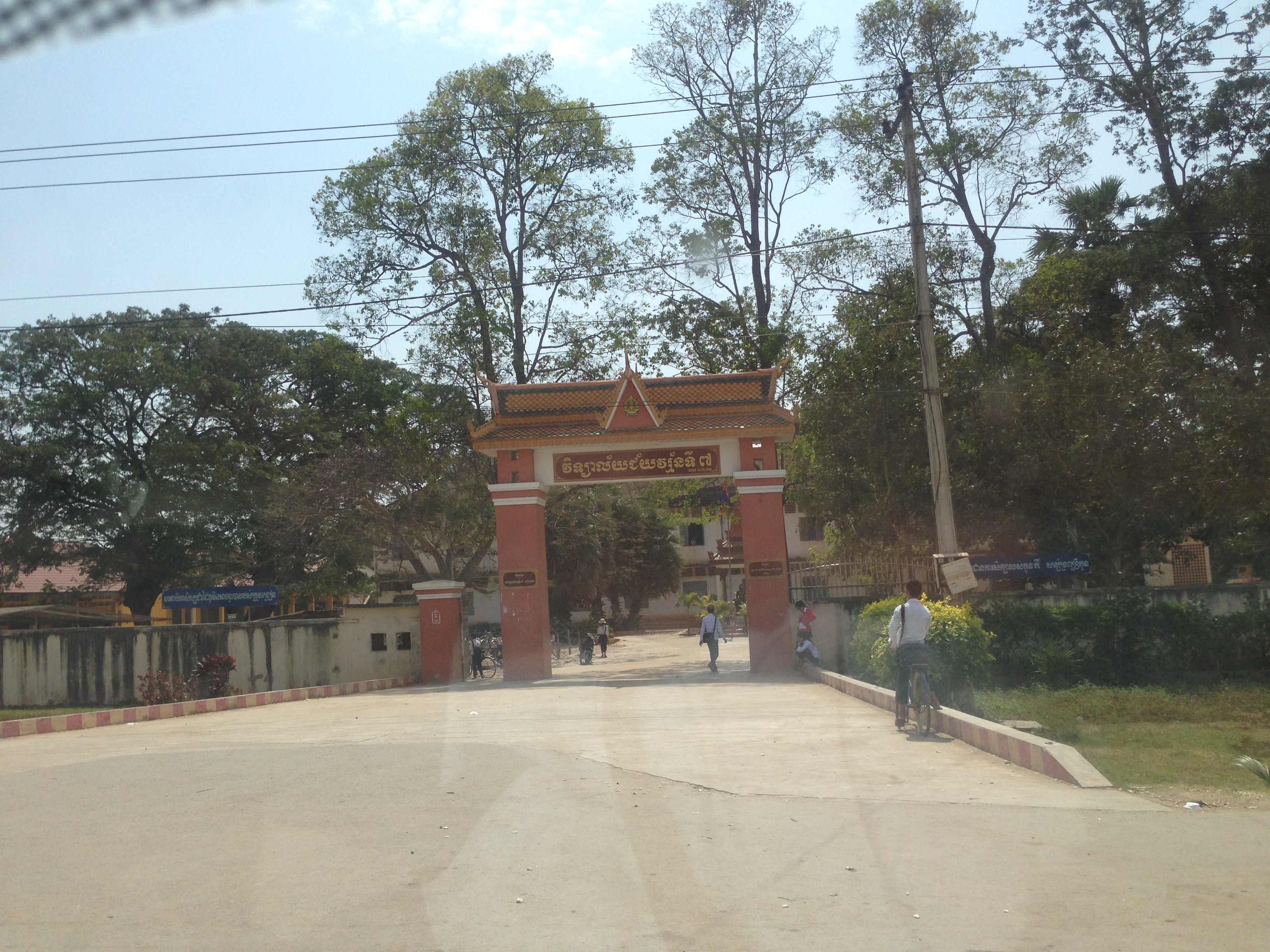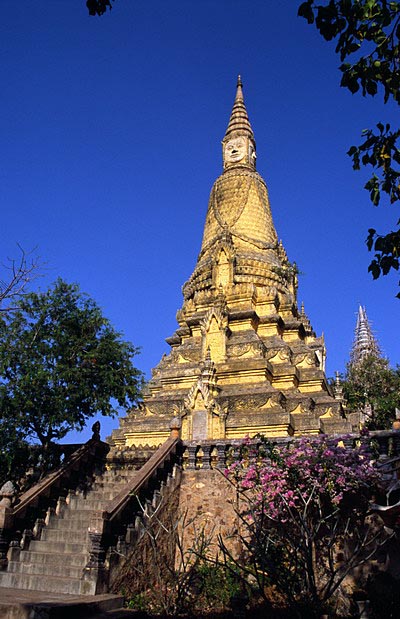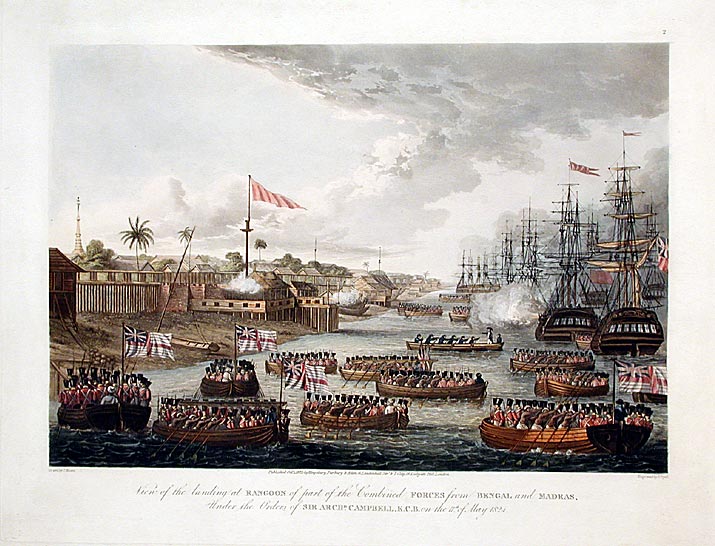|
Nil Teang
Samdech Preah Moha Sangkha Reach Nil Teang or Nil Tieng as it was written during the French protectorate of Cambodia, was the first Supreme Patriarch of Cambodia in the ''Mahanikaya''. He held that position during the reign of three consecutive kings: King Preah Ang Duong, King Norodom, King Sisowath. Biography A Cambodian child Nil Teang was born on Sunday, the 7th day of the month of Ashadha, corresponding to 4 July 1824 in Po Preah Bat district, Kien Svay province, present-day Kien Svay district in Kandal Province. He was the eldest son of a father named Nil and a mother named Lek. Education in Siam In 1831, when Teang was just eight years old, Vietnamese and Siamese troops fought in the Kien Svay area to conquer Cambodia. The family of Teang were captured by the Siamese army and taken to Siam as slaves. Teang and his grandmother were sent to live in Bangkok. He was sent to be educated at Wat Amarinthraram. There, Teang met a young man and future King Ang Duong when ... [...More Info...] [...Related Items...] OR: [Wikipedia] [Google] [Baidu] |
Supreme Patriarch Of Cambodia
The Supreme Patriarch of Cambodia (; , ) is the ''de facto'' leader of Buddhism in Cambodia. Titles The titles for the Cambodian Supreme Patriarchs are derived from Pali. The full official title of the Supreme Patriarch of the Maha Nikaya is ''Samdech Preah Sumedhādhipati'' (); ''sumedhādhipati'' means 'wise lord'. In letters with King-Father Norodom Sihanouk, the following title is used for the Great Supreme Patriarch Tep Vong: ''Samdech Preah Agga Mahā Sangharājādhipati'' (); which is translated as 'foremost great supreme patriarch leader'. The full official title of the Supreme Patriarch of the Dhammayuttika Nikaya is ''Samdech Preah Aphiserei Sukonthea Mohasangreacheathipadei (Abhisirī Sugandhā Mahāsangharājādhipati)'' (). This title means 'Of Higher Merit and Pure Virtue, Great Supreme Patriarch Leader'. In letters with King-Father Sihanouk, an abbreviated title is used in the valediction: ''Samdech Preah Sangreach'' ().' History Between 1855 and 1981, there were ... [...More Info...] [...Related Items...] OR: [Wikipedia] [Google] [Baidu] |
Kien Svay District
Kien Svay () is a district (''srok'') of Kandal Province, Cambodia. The district is subdivided into 12 communes (''khum''): Banteay Daek, Chheu Teal, Dei Edth, Kampong Svay, Kbal Kaoh, Kokir, Kokir Thum, Phum Thum, Preaek Aeng, Preaek Thmei, Samraong Thum, Veal Sbov, and 46 villages (''phum''). There is a "resort" of small shacks on stilts above a river near the town. This is a popular weekend jaunt for Phnom Penh residents. Kien Svay District lies on road number 1. It is connected between Phnom Penh Capital and Svay Rieng Province. Most people here are farmers. Education * High schools ** Jayavarman VII Jayavarman VII (), known posthumously as Mahaparamasaugata (, c. 1122–1218), was king of the Khmer Empire. He was the son of King Dharanindravarman II (r. 1150–1160) and Queen Sri Jayarajacudamani. He was the first king devoted to Buddhism, ... High School ** Samrong Thom Sannivo High School ** Hun Sen Serei Dei Dosh High School * Secondary schools ** Banteay Daek ... [...More Info...] [...Related Items...] OR: [Wikipedia] [Google] [Baidu] |
Bangkok
Bangkok, officially known in Thai language, Thai as Krung Thep Maha Nakhon and colloquially as Krung Thep, is the capital and most populous city of Thailand. The city occupies in the Chao Phraya River delta in central Thailand and has an estimated population of 10 million people as of 2024, 13% of the country's population. Over 17.4 million people (25% of Thailand's population) live within the surrounding Bangkok Metropolitan Region as of the 2021 estimate, making Bangkok a megacity and an extreme primate city, dwarfing Thailand's other urban centres in both size and importance to the national economy. Bangkok traces its roots to a small trading post during the Ayutthaya Kingdom, Ayutthaya era in the 15th century, which eventually grew and became the site of two capital cities, Thonburi Kingdom, Thonburi in 1767 and Rattanakosin Kingdom (1782–1932), Rattanakosin in 1782. Bangkok was at the heart of the modernization of Siam during the late 19th century, as the count ... [...More Info...] [...Related Items...] OR: [Wikipedia] [Google] [Baidu] |
Fall Of Longvek
The fall of Longvek, also known as the sack of Longvek or siege of Longvek, was the final act of the Siamese–Cambodian War (1591–1594), Siamese–Cambodian War which lasted from 1591 to 1594 and after which the Khmer capital Longvek was ransacked and looted. After the Khmer refused to recognize Ayutthaya authority, the Ayutthaya Kingdom besieged Longvek and sacked the capital city. After the fall of Angkor, the conquest of Longvek was another blow to Khmer sovoreignty, which was not restored for many more centuries, initiating the period known as the Dark ages of Cambodia, "dark age" of Cambodia. Sources The events concerning the Siamese army sacking the capital of Longvek at the end of the 16th century are mentioned in certain non-concording sources, such as: * the Cambodian Royal Chronicles, especially in the one published by Thiounn in 1936 * the Luang Prasoet Chronicle of Ayutthaya, originally written in 1780 AD, in the reign of king Narayana. It was translated into Eng ... [...More Info...] [...Related Items...] OR: [Wikipedia] [Google] [Baidu] |
Dhammayuttika Nikaya
Dhammayuttika Nikāya (Pali; ; ; , ), or Dhammayut Order (), is an order of Theravada Buddhist ''bhikkhus'' (monks) in Thailand, Cambodia, and Burma, with significant branches in the Western world. Its name is derived from Pali ''dhamma'' ("teachings of the Buddha") + ''yutti'' (in accordance with) + ''ka'' (group). The order began in Thailand as a reform movement led by a prince who would later become King Mongkut of Siam, before also spreading to Cambodia and Burma. Initially, King Mongkut was frustrated because he could not find monks who understood the original teachings of the Buddha and truly adhered to the rules of the monks. This happened because of the syncretism of Buddhism with Thai folk religion. Consequently, King Mongkut emphasized the use of the Pali Canon as the primary authority for monastic practices, and sought to eliminate all of the syncretic elements. The movement became formally recognized as its own monastic order by the Thai government in 1902, with an ... [...More Info...] [...Related Items...] OR: [Wikipedia] [Google] [Baidu] |
Silver Pagoda
The Silver Pagoda is located on the south side of the Royal Palace in Chey Chumneas, Phnom Penh. The official name is Wat Ubaosoth Ratanaram (), also known as Wat Preah Keo Morakot (Khmer: វត្តព្រះកែវមរកត, "Temple of the Emerald-Crystal Buddha") which is commonly shortened to Wat Preah Keo (Khmer: វត្តព្រះកែវ) in Khmer. The vihara houses many national treasures including many golds and jeweled Buddha statues. The most significant are a small green crystal Buddha (the "Emerald Buddha" of Cambodia — some sources maintain it was made of Baccarat Crystal in the 17th century but that's not possible since Baccarat Crystal didn't exist until the 18th century, and other sources indicate it was made in the 19th century by Lalique, a glass designer who lived in the 19th-20th century), and a life-sized gold Maitreya Buddha commissioned by King Sisowath, weighing 90 kg and dressed in royal regalia and set with 9584 diamonds, ... [...More Info...] [...Related Items...] OR: [Wikipedia] [Google] [Baidu] |
Josephinism
Josephinism is a name given collectively to the domestic policies of Joseph II, Holy Roman Emperor (1765–1790). During the ten years in which Joseph was the sole ruler of the Habsburg monarchy (1780–1790), he attempted to legislate a series of drastic reforms to remodel Austria in the form of what liberals saw as an ideal Enlightened state. This provoked severe resistance from powerful forces within and outside his empire, but ensured that he would be remembered as an " enlightened ruler" by historians from then to the present day. Origins Born in 1741, Joseph was the son of Maria Theresa of Austria and Francis I, Holy Roman Emperor. He was given a rigorous education in the Age of Enlightenment, with its emphasis on rationality, order, and careful organization in statecraft. Viewing the often confused and complex morass of Habsburg administration in the crownlands of Austria, Bohemia, and Hungary, Joseph was deeply dissatisfied. He inherited the crown of the Holy Roman Empire ... [...More Info...] [...Related Items...] OR: [Wikipedia] [Google] [Baidu] |
Si Votha
Si Votha (; also spelled Si Vattha; c. 1841 – 31 December 1891) was a Cambodian prince who was briefly a contender for the throne. He spent his entire life fighting his half brother Norodom of Cambodia, King Norodom for the throne. Si Votha was a grandson of King Ang Eng (reigning from 1772 to 1796) and a son of King Ang Duong. His biographical notes only record that he had a daughter named Neak Ang Mechas (Princess) Ang Duong Rath Votha. Si Votha had two half-brothers, Norodom of Cambodia, Norodom and Sisowath of Cambodia, with Norodom being the king's chosen heir. Succession struggle and 1861 rebellion Upon King Ang Duong's death, a succession struggle ensued, with Si Votha attempting to take power while his half brother Norodom was occupied with a rebellion; eventually Norodom gained the upper hand when he gained the backing of Sisowath. When Norodom was officially crowned king in 1864 in a joint coronation ceremony supervised by the France, French and Siamese officials, ... [...More Info...] [...Related Items...] OR: [Wikipedia] [Google] [Baidu] |
Khmer Inscriptions
Khmer inscriptions are a corpus of post-5th century historical texts engraved on materials such as stone and metal ware found in a wide range of mainland Southeast Asia (Cambodia, Vietnam, Thailand and Laos) and relating to the Khmer civilization. The study of Khmer inscriptions is known as Khmer epigraphy. Khmer inscriptions are the only local written sources for the study of ancient Khmer civilization. More than 1,200 Khmer inscriptions of varying length have been collected. There was an 'explosion' of Khmer epigraphy from the seventh century, with the earliest recorded Khmer stone inscription dating from 612 AD at Angkor Borei. Beyond their archeological significance, Khmer inscriptions have become a marker of national identity. Language: Sanskrit, old Khmer, and rarely Pali The languages used on Khmer inscriptions are either ancient Khmer or sanskrit while a few have also been found in pali, though the latter are no older than the 14th century. The oldest inscription in ... [...More Info...] [...Related Items...] OR: [Wikipedia] [Google] [Baidu] |
Oudong
Oudong (; also romanized as Udong or Odong) is a former town of the post-Angkorian period (1618–1863) situated in present-day ''Phsar Daek'' Commune, Kampong Speu Province, Cambodia, near the border between Kandal Province and Kampong Chhnang Province. Located at the foothill of the mountain Phnom Oudong, also known as Phnom Preah Reach Troap (), about 35 km northwest of the modern capital Phnom Penh via National Highway 5 (Cambodia), National Road No. 5, Oudong was a royal residence and Cambodia's capital for almost 250 years until 1866. A monumental royal necropolis of sovereigns of several centuries is scattered on top of the prominent bisected mountain, which runs from the southeast to the northeast. Etymology The city's name is derived from the Sanskrit word "" (), meaning tall, which probably refers to the mountain. As it had gained religious merit and significance it might have undergone extension towards: "great" or "supreme". History Oudong was founded by King Srei So ... [...More Info...] [...Related Items...] OR: [Wikipedia] [Google] [Baidu] |
Rama III
Nangklao (born Thap; 31 March 1788 – 2 April 1851), also known by his regnal name Rama III, was the third king of Siam from the Chakri dynasty, ruling from 21 July 1824 to 2 April 1851. Nangklao was the eldest surviving son of King Rama II. His mother Sri Sulalai was one of Rama II's secondary wives. Nangklao was likely designated as heir by his father. His accession was uncontested and smoothly confirmed by the grand council. Foreign observers, however, falsely perceived him as having usurped the prior claim of his younger half-brother Prince Mongkut, who was born to Queen Sri Suriyendra and thus " legitimate" according to Western customs. Under the old concept of Thai monarchy, however, a proper king must emulate Maha Sammata in that he must be "elected by the people." Ironically, Mongkut may have later contributed to this misconception, when he feared that his own accession might be perceived by foreign observers as a usurpation. During Nangklao's reign, the military heg ... [...More Info...] [...Related Items...] OR: [Wikipedia] [Google] [Baidu] |






